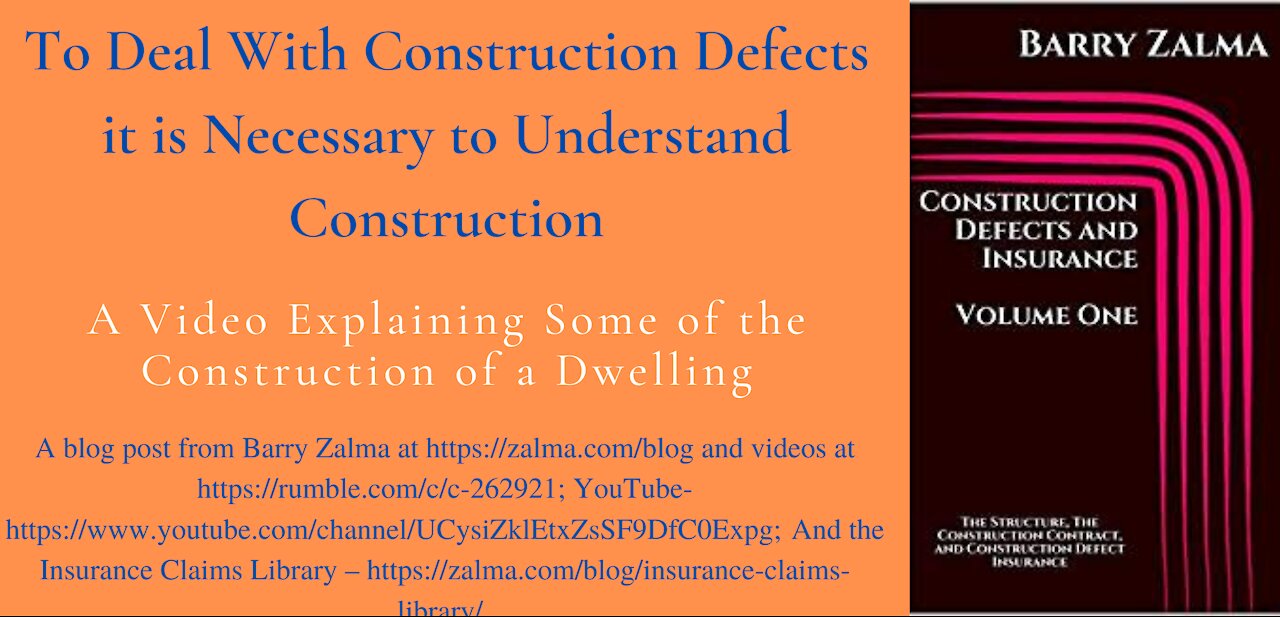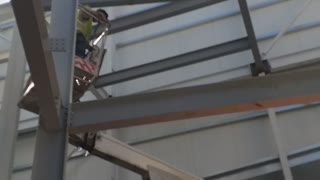Premium Only Content

To Deal With Construction Defects it is Necessary to Understand Construction
A Video Explaining Some of the Construction of a Dwelling
To understand the construction defect claim and the litigation surrounding construction defects, it is necessary to first have a basic understanding of construction, what is proper and prudent and what can go wrong. Building codes prescribe basic standards. When these standards are not followed, or not followed carefully enough, a building can fail. It may leak or lean or even fall down.
Typical single-family homes built during the last century were constructed with a wood frame built on top of a concrete foundation. The foundations are either raised on piers or poured flat on grade. The lumber that makes up the wood frame is usually jacketed with lath (thin wood strips) or a moisture barrier paper with a wire covering that is covered with stucco (a durable porous concrete product), exterior insulation and finish systems (artificial stucco) or wood or vinyl siding. The interior walls are usually finished with drywall (gypsum covered in paper that, when finished, gives the appearance of lath and plaster) or, in older structures, wood lath and plaster. Basic single-family dwellings are usually one to two stories in height and range from 900 to 3,500 square feet. Of course, there are also “mansions” where a single family may reside in a 20,000 square foot structure. It is becoming common to remodel old dwellings of 900 – 1100 square feet into 5,000 to 7,000 square foot “McMansions” on small residential lots. These extreme remodeling efforts often run afoul of claims of construction defect.
Footings
Failure of footings can cause the dwelling to sink, slip, or lean, causing plaster walls and stucco to crack; roofs, windows, and doors to lose their watertight seals; and doors to creak.
Foundations
In addition to footings, foundations can be created using piles of wood, concrete or sometimes metal columns that are driven into the ground and used to support the structure and prevent it from sinking. Piles are either driven down until they hit bedrock, or if bedrock is too difficult to reach, the piles are driven to a depth where the soil friction against the side of the pile is sufficient to prevent any further downward movement.
Framing
Standard walls are 8 to 12 feet high. Boards approximately two inches by six inches (2x6s) are commonplace in residential construction because they provide a wider cavity that accommodates more insulation than the standard; approximately two inch by four inch boards (2x4s). The 2x4 is still most popular for most remodeling and add-ons.
Framing consists of top and bottom plates, wall studs, headers, and trimmers/king studs as needed for window and door openings.
© 2021 – Barry Zalma
Barry Zalma, Esq., CFE, now limits his practice to service as an insurance consultant specializing in insurance coverage, insurance claims handling, insurance bad faith and insurance fraud almost equally for insurers and policyholders.
He also serves as an arbitrator or mediator for insurance related disputes. He practiced law in California for more than 44 years as an insurance coverage and claims handling lawyer and more than 54 years in the insurance business.
He is available at http://www.zalma.com and [email protected]. Mr. Zalma is the first recipient of the first annual Claims Magazine/ACE Legend Award. Over the last 53 years Barry Zalma has dedicated his life to insurance, insurance claims and the need to defeat insurance fraud. He has created the following library of books and other materials to make it possible for insurers and their claims staff to become insurance claims professionals.
Go to the podcast Zalma On Insurance at https://anchor.fm/barry-zalma; Follow Mr. Zalma on Twitter at https://twitter.com/bzalma; Go to Barry Zalma videos at Rumble.com at https://rumble.com/c/c-262921; Go to Barry Zalma on YouTube- https://www.youtube.com/channel/UCysiZklEtxZsSF9DfC0Expg; Go to the Insurance Claims Library – https://zalma.com/blog/insurance-claims-library/ Read posts from Barry Zalma at https://parler.com/profile/Zalma/posts; and the last two issues of ZIFL at https://zalma.com/zalmas-insurance-fraud-letter-2/ podcast now available at https://podcasts.apple.com/us/podcast/zalma-on-insurance/id1509583809?uo=4
-
 13:02
13:02
Barry Zalma, Inc. on Insurance Law
1 year agoMurder Pays
4401 -
 17:20
17:20
Barry Zalma, Inc. on Insurance Law
4 years agoTo Deal With Construction Defects it is Necessary to Understand Construction - Two
113 -
 17:52
17:52
Barry Zalma, Inc. on Insurance Law
4 years agoConstruction Defects and Insurance
144 -
 16:52
16:52
Barry Zalma, Inc. on Insurance Law
4 years agoAdditional Construction Defects
47 -
 18:36
18:36
Barry Zalma, Inc. on Insurance Law
4 years agoA Video Explaining More Construction Defects
105 -
 16:14
16:14
Barry Zalma, Inc. on Insurance Law
4 years agoA Video Explaining Construction Defects and Exclusions to Coverage
78 -
 0:13
0:13
marioblue
4 years agoMetal construction with crane
271 -
 15:47
15:47
Barry Zalma, Inc. on Insurance Law
4 years agoA Video Explaining Construction Defects and Insurance
42 -
 4:04
4:04
eulan06
4 years agoConstruction of Mausoleum At Home with Landscaping
24 -
 1:17
1:17
Sean Hannity
4 years agoHannity: Kamala Harris doesn't understand why a border visit is necessary
10.9K92